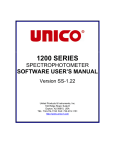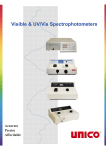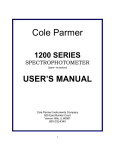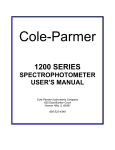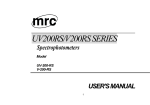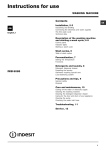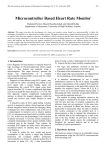Download SERVICE MANUAL
Transcript
1100 SERIES SPECTROPHOTOMETER Model 1100 and Model 1100RS SERVICE MANUAL UNITED PRODUCTS & INSTRUMENTS INC. 182 Ridge Road, Suite E Dayton, NJ 08810, USA TEL: 732-274-1155 FAX: 732-274-1151 http://www.unico1.com CONTENTS 1. GENERAL 1.1 Introduction 1.2 Optical System 1.3 Electronic System 1.4 Specifications 1.5 Operation Panel 2. INSTALLATION 3. MAINTENANCE 3.1 Working Environment 3.2 Lamp Replacement and Adjustment 3.3 Wavelength Calibration 4. SERVICE 4.1 Physical Inspection 4.2 Operating Procedure Check 4.3 Troubleshooting 5. DRAWING AND DIAGRAM 5.1 PCB Arrangement of Power Supply 5.1.1 Circuit Diagram of Power Supply 5.2 PCB Arrangement of CPU 5.2.1 Circuit Diagram of CPU 5.3 PCB Arrangement of Amplifier 5.3.1 Circuit Diagram of Amplifier 6. SCHEMATIC LAYOUT 6.1 Schematic Diagram of UNICO® 1100 Series 7. SERVICE PARTS 2 3 3 5 6 9 9 11 12 12 12 13 16 16 16 19 26 27 28 29 30 31 32 33 34 35 1. GENERAL 1.1 Introduction ® The UNICO Model 1100 Series spectrophotometers are single beam general purpose instruments designed for use in conventional laboratories. The instruments are ideal for various applications such as: Clinical Chemistry, Biochemistry, Food and Beverage Laboratories, Environmental Protection, Water and Waste Water Labs, and other fields of quality control. ® The UNICO 1100 Series spectrophotometers cover the visible wavelength range from 335 nm to 1000 nm. The analytical grating system has 1200 lines/mm for higher dispersion of the spectrum. Figure 1-1.1 and Figure 1-1.2 show Model 1100 and Model 1100RS respectively. 3 Figure 1-1.1 Figure 1 -1.2 UNICO® 1100 Spectrophotometer UNICO® 1100RS Spectrophotometer 4 1.2 Optical System As shown in Figure 1-2 the white light coming from the Halogen Lamp is focused by the collecting lens, pass through the Entrance slit of the Monochromator, through a collimating lens to the Analytical grating where it is dispersed into its spectrum, then through the Exit slit of the monochromator, continues through the Sample C ompartment and finally to the Photo detector. Figure 1-2 OPTICAL SYSTEM SCHEMATIC DIAGRAM 1. Halogen Lamp 3. Entrance Slit 5. Grating 7. Sample 9. Photodiode 2. Collecting Lens 4. Collimating Lens 6. Exit Slit 8. Collimating Lens 5 1.3 Electronic System The photo detector receives the monochromatic light and generates photocurrent. A direct current signal which is proportional to the amount of light energy to the photo detector. The signal is then amplified and processed. The processed signal is sent to the digital display and also to the external outputs — analog output (0~1 Volt) or RS-232C output. Figure 1-3.1 and Figure 1-3.2 demonstrates the electronic system of Model 1100 and Model 1100RS respectively . 6 7 8 1.4 Specifications Table 1-4 Model Specifications* for Model 1100 and 1100RS 1100 1100RS Wavelength Range Spectral Slit Width Wavelength Accuracy Wavelength Readability Stray Radiant Energy Photometric Range Photometric Accuracy Photometric Noise L e v e l Requireme nt Power Size Weight 335~1000 nm 20 nm 10 nm 10 nm ± 2 nm ± 1 nm ≤ 0.5%T at 340 nm and 400 nm 0~125%T 0~ 125%T 0~2.0 Abs 0~ 2.0 Abs 0~1999C (0~1999 Factor) ± 2.0%T ± 1.0%T ± 2.0%T ± 1.0%T 115/230 V ±10%, 60/50 Hz 408 (W)×308 (D)×180 (H) (mm) 6kg (13 lbs) * Specifications subject to change without notice 1.5 Operation Panel Refer to Figure 1-1.1 and Figure 1-1.2 for the Operation Panel of Model 1100 and Model 1100RS. Figure 1-5 shows the Backside Panel of Model 1100 and Model 1100RS. Figure 1- 5 Backside Panel of Model 1100/1100RS 1100 Spectrophotometer Operation Panel Mode Indicator: Show the current measurement mode (T--%Transmittance, A--Absorbance) (refer to Figure 1-1.1). MODE Button: Switch between T and A measurement modes. 9 0A/100%T Button: Adjust Digital Display reading to 100%T or 0.000A when blank reference solution is in Sample Compartment. Sample Compartment: Accept 10 mm test tube or 10 mm square cuvette (the square cuvette adapter is required). WAVELENGTH (Wavelength Control) Knob: Select desired wavelength in nanometers (nm). Wavelength Readout Window: Display desired wavelength. 1100RS Spectrophotometer Operation Panel Mode Indicator: Show the current measurement mode (T--%Transmittance, A--Absorbance, C--Concentration, and F--Factor) (refer to Figure 1-1.2). MODE Button: There are four modes. T mode is transmittance mode; A mode is absorbance mode; C mode is to measure unknown sample concentration through a standard solution; F mode is to measure unknown value with a previously determined factor. ? (0A/100%T) Button: Adjust Digital Display reading to 100%T or 0.000A when blank reference solution is in Sample Compartment. ? (0%T) Button: When in T mode and the Sample Compartment is empty, a shutter blocks the beam. Press ∨ button to adjust the Digital Display reading to 00.0%T. ENT (PRINT) Button: When pressed: At A and T modes, send the displayed results to printer; At C mode, s et the concentration value (refer to Concentration Mode in Additional Features of Model 1100RS section); At F mode, set the factor number and change to C mode (refer to Factor Mode in Additional Features of Model 1100RS section); If connected with a PC using UNICO® Windows -based Application Software, the communication with ® the PC will be set up (refer to the UNICO 1100 Series Spectrophotometer Software User’s Manual Version SS-1.11 for details). Sample Compartment: Accept 10 mm test tube or 10 mm square cuvette (the square Cuvette Holder is required). WAVELENGTH (Wavelength Control) Knob: Select desired wavelength in nanometers (nm). Wavelength Readout Window: Display desired wavelength. 10 2. INSTALLATION The instrument should be installed in a clean environment which is free of corrosive materials, dust and severe vibrations. Furthermore, it should be kept away from any strong electric magnetic fields and high frequency fields. The power can be selected by adjusting the built-in switchable power switch to match the line voltage in your region. 11 3. MAINTENANCE 3.1 Working Environment The optimum environment for the instrument is as follows: TEMPERATURE HUMIDITY 5~35 °C = 85% Install the instrument in a clean non-vibrational area. Avoid direct strong light and air flow. The instrument will give better performance if the power supply stability is at 1% and line frequency less than 1 Hz. Always allow the instrument to warm up for 15 minutes prior to taking any readings. 3.2 Lamp Replacement and Adjustment 1. Turn off and unplug the instrument. Turn the instrument upside down. 2. Remove the grill plate on bottom of the instrument by removing the fixing screw. 3. Unplug the lamp from the white connector. Insert the new lamp; pushing it in as far as it will go. CAUTION: DO NOT HANDLE THE LAMP WITH BARE FINGERS. USE TISSUE OR CLOTH WHEN HANDLING LAMP. 4. Turn on the instrument. Set the wavelength at 340 nm, insert a test tube or an empty cuvette with cuvette holder, and blank the instrument. If the energy is low, adjust the lamp by “pulling”or “pushing”it so that the light beam is focused on the entrance slot of the monochromator. Since the lamp socket is pre-aligned, there will be minimum, if any, adjustment required. 5. Re-install the grill plate. 12 Figure 3-1 Replacing the L amp 3.3 Wavelength Calibration Normally the UNICO® 1100 Series spectrophotometer retains its wavelength calibration indefinitely. However if the instrument receives a severe shock or is abused, use the following methods to check wavelength calibration. Please note that this test requires the UNICO® Didymium filter, p/n S-2100-116, or the Holmium Oxide filter, p/n S-2100-115. In the filter method, the didymium filter has two distinct absorbance peaks at 529 nm and 807 nm. The Holmium filter has a distinct peak at 361 nm. When the instrument is calibrated properly you will find minimum Transmittance (maximum Absorbance) at the range ± 2 nm from these peaks. Note that the specific Transmittance values are not important as you are only looking for the wavelength where the minimum Transmittance (maximum Absorbance) occurs. Note: If you calibration filter has a certified peak/valley curve attached, please use the peaks on the curve to verify the instrument. Holmium Oxide Filter Method 1. Turn instrument on and allow it to warm up for 15 minutes. 2. Select the A mode. 3. Set the wavelength to 350 nm. 4. Make sure the Cuvette Holder is empty and place it in the Sample Compartment. Close the lid. 5. Set zero Absorbance by pressing the 0A/100%T (∧) button. Wait a few seconds when the display flashes. The reading should be 0.000A. If not, repeat step 5. 6. Remove the Cuvette Holder and insert the Holmium filter into it. Place it in the Sample Compartment again and close the lid. 7. Record the Absorbance reading on the Digital Display window. 8. Advance the wavelength setting by 1 nm and repeat step 4 to 7. 9. Repeat step 8 until the wavelength setting reaches 370 nm. 10. Look for the maximum absorbance reading obtained, and this should be found between 359~363 nm. The wavelength accuracy of the 1100/1100RS is ± 2 nm. Didymium Filter Method 1. Set the Wavelength to 800 nm. 2. Make sure the Cuvette Holder is empty and place it in the Sample Compartment. Close the lid. 3. Set zero Abs by pressing the 0A/100%T (∧) button. Wait a few seconds when the display flashes. The reading should then be 0.000A. If not, repeat step 3. 4. Remove the Cuvette Holder and insert the Didymium filter into it. Place it in the Sample Compartment and close the lid. 5. Record the Absorbance reading on the Digital Display window. 13 6. Advance the wavelength setting by 1 nm and repeat step 2 to 5. 7. Repeat step 6 until the wavelength setting reaches 815 nm. 8. Look for the maximum absorbance reading obtained, it should be between 805 and 809 nm. The wavelength accuracy of the 1100/1100RS is ± 2 nm. 9. If a “middle”wavelength check is desired, set the wavelength to 522 nm (optional) 10. Make sure the Cuvette Holder is empty and place it in the Sample Compartment. Close the lid. 11. Set zero Abs by pressing the 0A/100%T (∧) button. Wait a few seconds when the display flashes. The reading should then be 0.000A. If not repeat step 11. 12. Remove the cuvette holder and insert the Didymium filter into it. Place it in the Sample Compartment again and close the lid. 13. Record the absorbance reading on the Digital Display window. 14. Advance the wavelength setting by 1 nm and repeat step 10 to 13. 15. Repeat step 14 until the wavelength setting reaches 536 nm. Again, look for the maximum absorbance reading. It should be between 527 and 531 nm. Absorbance Accuracy Check Specification: ± 2% at 1A (1100), ± 1% at 1A and 2A (1100RS). The absorbance accuracy should be checked against a set of neutral density filters accurately calibrated to the NIST standards. Contact your ® UNICO representative for more information (800-588-9776). An alternative method using potassium dichromate is described below. Due to the many factors that might affect the results (i.e. temperature, bandpass, weighing and diluting errors), this method is less accurate and should only be used as a guide. Reference: Johnson E A Potassium Dichromate as an absorbance standard PSG Bulletin 1967, No. 17, page 505 1. 2. 3. 4. 5. 6. 7. 8. Make up N/100 sulfuric acid as the solvent and use part of it to make a solution containing 120 + 0.5 mg/l of potassium dichromate. Wash out a square cuvette with solvent, and fill with solvent. Put the cuvette in the Cuvette Holder, then into the Sample Compartment and close the lid. Set the wavelength to 350 nm. Set the MODE button to A. Set the reading to 0.000A using the 0A/100%T (∧) button. Empty the cuvette . Wash out with dichromate solution, and fill with dichromate solution. Put the cuvette in the Cuvette Holder, then into the Sample Compartment and close the lid. 14 9. Read the absorbance of the standard from the Digital Display window. The value should be 1.288 ± 0.04 A. Refer to the notes above when interpreting the result. Stray Light Check Specification: Less than 0.5%T at 340 nm by ASTM E 387 A good indication as to whether the stray light level is within specification may be obtained as follows: 1. 2. 3. 4. 5. 6. Set the wavelength to 340 nm. Set the MODE button to T. With the square Cuvette Holder in the Sample Compartment, but no cuvette, close the lid and press the 0A/100%T (∧) button to set the display to 100.0%. Remove the Cuvette Holder from the Sample Compartment and close the lid. Make a note of the reading that should be at or near 0.00. Prepare a solution containing 50 mg/l of sodium nitrite (NaNO2) in distilled water and fill a square cuvette with this solution. Insert the cuvette into the Cuvette Holder, place it in the Sample Compartment, and close the lid. The display should read < 0.5%T. If the reading obtained in step 4 is greater than 0.00, it should be subtracted from the displayed reading to give the correct reading for the stray light value. 15 4. SERVICE 4.1 Physical Inspection Thoroughly inspect the instrument for physical indications that might cause a malfunction. The following categories are usually checked: Apparent damage, Dirty Optics, Broken wire, loose connection, P.C. Board loose, Broken lands on pc board, any sign of overheated components. 4.2 Operating Procedure Check Each time an instrument has a malfunction, the operating procedure should be checked. If necessary such procedures should be repeated to see the patterns that the malfunction occurs. The basic operating procedure is as follows. Basic Operation Simple OPERATION INSTRUCTIONS are printed on the front panel of ® your UNICO 1100/1100RS. Sample Preparation and Analysis A. Spectrophotometer Warm-up 1. Turn on the spectrophotometer by turning on the Power Switch (IO). Allow 15 minutes for the instrument to warm up. 2. Select either the T (Transmittance Mode) or A (Absorbance Mode) by pressing the MODE button until the red light for T or A is on. 3. Select the desired wavelength by turning the WAVELENGTH control knob. B. 4. 5. 6. Sample Preparation Make a blank reference solution by filling a clean square cuvette (or test tube) half full with distilled/de-ionized water or other specified solvent. Wipe the cuvette with tissue to remove the fingerprints or droplets of liquid. Insert the blank square cuvette into the square cuvette adapter and place the adapter in the Sample Compartment (if using test tube, insert it directly into the Sample Compartment, aligning the guide mark (if present) with the guide mark at the front of the Sample Compartment). Close the lid. Set 0.000A or 100%T with the 0A/100%T (∧) button. NOTE: This step fulfills the instruction on the front of the spectrophotometer (Set Full Scale). 7. Remove the blank square cuvette or test tube. Set it aside in case that you may need to adjust the 0A/100%T using 0A/100%T (∧) button 16 later (i.e. change the wavelength). C. 8. 9. 10. 11. 12. Sample Analysis Rinse a second square cuvette with a small amount of the sample solution to be tested. Fill the square cuvette half full and wipe it. Put the sample cuvette in the Sample Compartment. Close the lid. Read the T or A from the Digital Display window. Remove the sample cuvette or test tube. If you are to test the same sample at other wavelengths, repeat step 3 to 10 for each wavelength. For each new sample you analyze, repeat step 2 to 11. Additional Features of Model 1100RS 1100RS offers two more features--Concentration Mode--C and Factor Mode--F though operating basically the same as the Model 1100. Concentration Mode C is used for determining the concentration of unknown samples. NOTE: This method should only be used when the relationship between Absorbance and Concentration is known to be linear. The concentration of the Standard solution used to calibrate the instrument should be higher than the most concentrated sample. 1. 2. 3. 4. 5. 6. Select the desired wavelength by turning the wavelength control knob. Using the MODE button, select A mode. Insert the cuvette containing the blank solution. Set 0.000A with the ? button. Using the MODE button, select C mode. Insert a cuvette containing a standard solution of known concentration in the Sample Compartment and set the Digital Display window to be the value of the standard by using the ? and ? buttons. 7. Press the ENT button. NOTE: If the reading changes, the factor required is too high (i.e. >1999) to be displayed. In this case, divide the concentration by 10; re -select the C mode by successive presses on the MODE button, cycling through the F, T, and A modes, and follow step 2 above to set the concentration of the standard to the reduced value. 8. With the standard concentration set, determine the concentration values of samples with unknown concentration by inserting the sample cuvette into the Sample Compartment and reading the value direct from the Digital Display. 9. To read the value of the multiplier used to convert Abs to Concentration, after measuring all the samples, change the mode to F and read the multiplier from the display. Keep a record of this value for future use. 17 Operational Note: if the MODE is changed to read F or A, the Concentration C reading is “frozen, re-start at step 1. Factor Mode This is a special mode for measuring concentration values of unknown samples using a previously determined factor to convert absorbance readings to concentration. 1. After setting the wavelength, and setting zero Abs on the blank solution, using the MODE button, select F mode. 2. Insert a cuvette containing a sample. 3. Using the ? and ? buttons, set the Digital Display window to the desired value of the multiplier. 4. Press the ENT button. The spectrophotometer switches to the C mode. Operational Note: If the Concentration of the sample is too high to be displayed, the instrument will not switch to C mode when the ENT button is pressed. Dilute the sample and multiply the concentration reading by the dilution factor to obtain the original sample concentration. If dilution is impossible or causes other problems, you may divide the factor value by “10” or “100”and follow step 1 to 4 to enter the “new”factor value. You need to calculate the sample concentration by multiply ing readout with the multiple “10” or “100”. 5. Read the concentration value of the sample direct from the Digital Display. 6. Insert a cuvette containing the next sample and read the result. Repeat until all samples have been measured. Operational Note: If the MODE is changed to A or T and the concentration reading is “frozen”,re-start at step 1. 18 4.3 T roubleshooting Troubleshooting #1 Problem: Turn on, No display N Y Pilot light on? N Is 115V or 230v power on? Y N Line power on Display on? N Switch function? N Check if LCD display and wiring OK? Y PC power Function? Y N A: Replace CPU board Absolving wiring problem or replace socket A2, A3 Replace R13-69A switch N Replace PC power Check the +8V and –8V On the power supply board? Y Is diode working fine? How about wiring? Refer to Fig.5.1.1 to check +8V and –8V power supply supply N A: Replace φ3 green diode Absolving wiring problem 19 Troubleshooting #2 Problem: Instrument is on, Display 0.000(%T) or 1--N N Halogen lamp on? Check lamp OK? Y Y N Anything in sample compartment blocking the light? Replace lamp Check output of lamp Power supply, is it Between +1.6V to 6.2V Y Y Remove it Is cell holder and Cuvette in position? Y Refer Fig.5.3 to check W lamp power supply N Install cell holder cuvette N Shutter operation? Repair shutter Y N Halogen lamp peaked? Y Amplifier detector working fine? Y Adjust the lamp position (keep shutter open, put a white paper into optical path in sample compartment) at 525nm, you should see bright green light on paper A: check S1227K photocell Briefer Fig.5.3.1 to check amplifier C: solving wiring problem 20 Troubleshooting #3 Problem: Turn on, put in cell holder and cuvette, display “<<10.0”, Is the position of halogen lamp N Y Adjust the position of halogen lamp, put a piece of white rectangle paper into sample compartment (open the shutter), can see a whole, clear, bright facula Is the light road out of the position N Y Right filter in position? N Adjust light road with right way, put apiece of white rectangle paper (open the shutter), can see a whole, clear, bright facula Adjust the filter with right way 21 Troubleshooting #4 Problem: Instrument on Display “1— — — ” (T%) or show negative at absorbance Is sample compartment cover closed? N Close sample Y Is cell holder and cuvette in position? the N Y Shutter working Put the cell holder and cuvette into the sample compartment Y N Repair shutter assembly Press “100%”, after display “100.0” open the sample compartment cover if the display changed? N N Is regulate power supply normal Y 1. Solving wiring problem of J5 socket. 2. replace IC4 (74LS07) 、 IC5 (4051BE) on the power supply board. 3. replace power supply board. 1. Amplifier working N 2. Solving wiring problem. 3. Refer Fig.5.6 to check amplifier. 22 Troubleshooting #5 Problem: Instrument on → “100.0”display not stable (T) N Enough warm up time? Warm up at least 20 min Y N Grounding OK? Y Power supply OK Y After changed wavelength stable time full Improve grounding N Get rid of possible interference factors N After 5 min press “100%”again Y ±12V power supply work stable N Replace PC power supply Y Regulate power supply working Y N Refer to Fig5.3.1 to check regulate power supply of halogen lamp N Electric eye working Y Amplifier working Replace the same electric eye (S1227K) N Check amplifier 23 type Troubleshooting #6 Problem: measuring results incorrect (not stable, Is sample preparation adjust right? Y Is sample preparation Installed correctly? Y N a b c d e f use right procedures to prepare samples make sure no bubble in sample test only after sample stability select right wavelength get rid of possible interference factors Are cuvettes used matched? N Y Install the compartment correctly Is wavelength accurate? N Y Use matched cuvette Difference should be Within 0.5%T Are %T and 100%T correct? Y N Is photometric accuracy maintained? N Calibrate wavelength Use right procedure to set N 24 1. Check if the monochromator light passed onto the detector at right angle and right position (area) of the detector if not, adjust it. 2. Amplifier output voltage (static): 20 mV~30 mV put black body to prevent the light from light way, refer to Fig5.3 to adjust the potentiometer W to change the output voltage to 20 mV~30 mV (measure the voltage between pin3 and pin4). 3. Replace detector SI1227K. 4. Use NBS930D filter to check. 5. If the value of display too big, check the control single of halogen lamp ¡ solving wiring problem of socket J5 ¡ replace IC4 IC5 on the power supply board ¡ replace power supply board 25 5. Drawing & Diagram 5.1 PCB Arrangement of Power Supply 5.1.1 Circuit Diagram of Power Supply 5.2 PCB Arrangement of CPU 5.2.1 Circuit Diagram of CPU 5.3 PCB Arrangement of Amplifier 5.3.1 Circuit Diagram of Amplifier 26 27 28 29 30 31 32 6. Schematic Layout ® 6.1 Schematic Diagram of UNICO 1100 Series Table 6-1 Parts in the Schematic Diagram of UNICO® 1100 Series Number Description On/Off Switch 1 Pc-power 2 Power socket 3 Wavelength disc 4 Wavelength indicator 5 Part of grating 6 7 Monochromator Sample compartment 8 Filter drive strap 9 Filter commutation cam 10 Amplifier dark box 11 Amplifier 12 Halogen lamp 13 Junction-box 14 Transistor 15 Radiator 16 Power supply board 17 33 34 7. SERVICE PARTS Table 7 Service Parts List for Model 1100 and 1100RS Catalog # S-1100-102 S-1100-103 S-1100-505 S-1100-535 S-1100-801 S-1100-801E S-1100-802 S-1100-803 S-1100-804 S-1100-805 S-1100-811 S-1100-811A S-1100-812 S-1100-813 S-1100-891 S-1100-892 S-1100-893 S-1100-894 S-1100-895 S-1100-896 S-1100-897 S-1100-898 S-1100-899 Description Test Tube Sample Holder for 10 mm Diameter Test Tubes Square Cuvette Adaptor for 10 mm Cuvettes Halogen Bulb (6V 10 W G4 type) Package of 2 Fuse, 3 A, Quantity 1 (size 5 x 20) Power Cord USA Plug Power Cord European Plug On/Off Switch Lamp Socket (G4 type) Power Supply Switch (110 V/220 V) Power Supply Unit Detector/Amplifier Board for Model 1100 Detector/Amplifier Board for Model 1100RS CPU Board with Digital Display Power Supply Board Wavelength Knob Rubber Feet Drain Cap Analog Output Port for Model 1100 Wavelength Indicator Operation Panel for Model 1100 Operation Panel for Model 1100RS Wavelength Disc Second Filter Belt 35







































